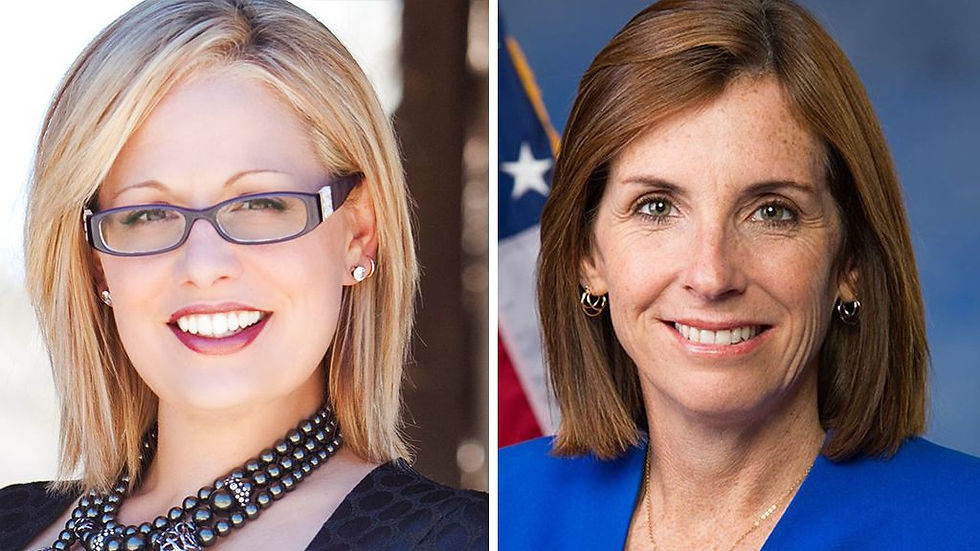Parties, Lies, and Video: Demise of an American Legislator
- Carl B. Forkner, Ph.D.
- Nov 18, 2018
- 4 min read

In his farewell Presidential address, George Washington advised American citizens to view themselves as a cohesive unit and avoid political parties and issued a special warning to be wary of attachments and entanglements with other nations. [1]
“Warring against [the principles] of the people,… there is no length to which [the delusion of the people] may not be pushed by a party in possession of the revenues and the legal authorities of the United States, for a short time indeed, but yet long enough to admit much particular mischief. There is no event, therefore, however atrocious which may not be expected.” [2]
The 2018 Arizona senatorial race was one of the most hotly contested–and closely watched–races in the country this fall. I have a unique position of knowing both Rep. Martha McSally (R-AZ2) and Rep. Kyrsten Sinema (D-AZ9) personally, and so this year’s campaign was a shocker–maybe I really didn’t know Rep. McSally? Certainly, the person I knew was not the person portrayed this year. The 2018 AZ Senate race pitted Sinema–who has never published or approved a negative campaign ad–against McSally–whose campaign was fraught with blatant negativity, misrepresentations, embellishments, and flat-out lies. The result, although closer than one might expect, was McSally’s defeat–substantively at her own hand because of the negativity and brutal nature of her campaign.
If one steps back 15 years in our history, the imploding of McSally–or a similar candidate–was inevitable. After the real and perceived missteps of the 2003 invasion of Iraq under President George W. Bush that started a great divide in America, and then nearly a decade of both partisan and racial division under President Obama, it was only a matter of time before utter negativity and partisan brutality would infect a candidate to the point that he or she was unrecognizable–and unrecoverable. With the headstrong leadership of President Trump and his stalwart support of Republican congressional candidates, the final component of the explosion was in place and ready to ignite.
But then again, is this not a pattern in American politics and American society in general? Those living in America have been poisoned by bias–both liberal and conservative–instead of being presented with facts and being allowed to do their own analyses. It does not matter which U.S. network you choose to watch; every U.S. network injects bias into their “newscasts” from selection of stories to selection of facts to anchor/reporter personal commentary that reduces some newscasts to little more than talk show status. As a result of this environment–both a decade and a half of leadership actions and media bias as core influences–the American experience has become one that focuses on flaws or differences, where people first observe what they do not like or what is different instead of seeking negotiated compromise based on common grounds. The “American Dream,” as it was, has lapsed into the “American Entitlement” in the minds of up-and-coming generations of future leaders–no longer a necessity to work hard to accomplish goals; rather, to continue turning oxygen into carbon dioxide and putting out one’s hand.
Arizona was in a unique position in the 106-year history of the state–the first time that it was guaranteed that a woman would represent the state in the Senate–it was a landmark election that demonstrated that gender and capability were not a cause-and-effect relationship. Both McSally and Sinema are highly intelligent, experienced, and have a legacy of service–McSally in the US Air Force and as a Congresswoman, and Sinema as an educator, lawyer and Congresswoman. Both are outstanding individuals; neither are perfect, as human beings tend not to be. Here, however, is where a major difference led to the result of the election…
Now, I use an analogy for life that uses driving as an illustration. One spends 10% of their time looking out of each of three rear-view mirrors, which gives them three perspectives on where they have been. One spends 10% of their time looking out of each of the left and right windows, gaining perspectives on their current situation. Most importantly, one spend 50% of their time looking forward, with their eye on a goal and making sure to stay on the road leading to those goals. It is in this respect that the candidates were diametrically opposed. McSally spent all but the final week or so of her campaign looking backwards--sometimes over 20 years in the past--and pointing fingers at Sinema, which caused her campaign and public opinion to diverge from the desired course and goal. Conversely, Sinema used past accomplishments to outline her plans and programs for the future, focused on the needs of Arizona’s citizens instead of those of her own–which was supported by her incredible reputation and record for serving her constituents in Arizona’s Ninth Congressional District. This kind of legacy was missing–not there unless you were at a military base or an A-10 squadron–which hurt solidarity of constituents for McSally. But, of course, besides the military bases and “The Wall,” there was little discussion of platform or way ahead.
Some may say that Sinema was elected because Maricopa County (where Phoenix is located) pretty much runs things at that level; however, history will show that they are wrong! Sinema is the first Democrat to be elected to the Senate from Arizona since 1977 (and, of course, the first woman, as would McSally had been if she won).
America needs to hit the reset button. We must turn the tide from seeking out differences to seeking out common ground. Without shoring up American society by rediscovering the balance between personal liberties and the common good–a premise that the Founding Fathers placed at the foundation of our Constitutional Republic–America cannot heal. Let us look for the good, report the good, and seek common ground for negotiating what is best for these United States of America and her citizens.
References:








Comments